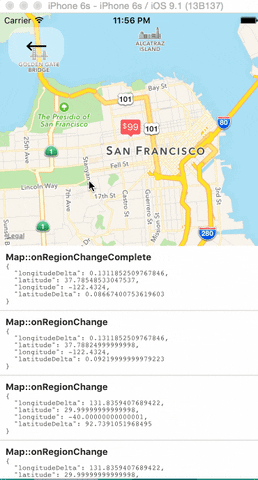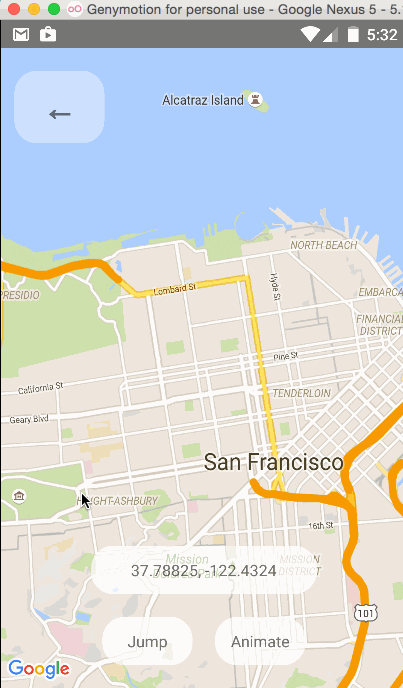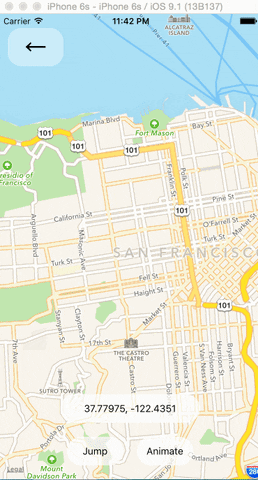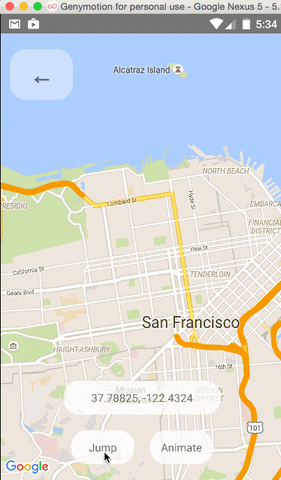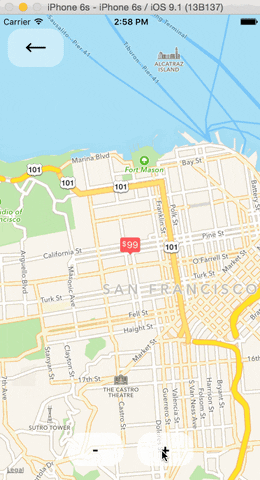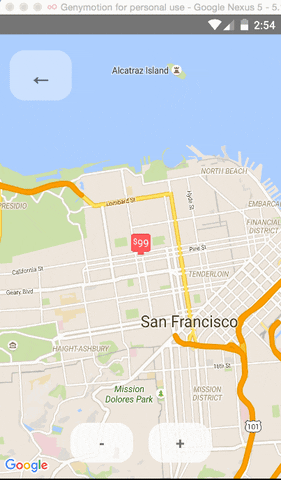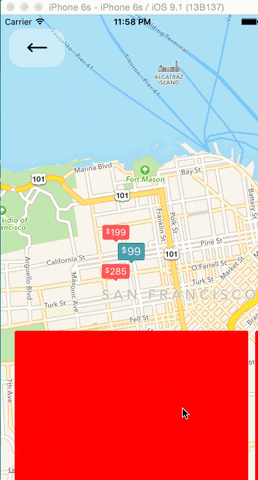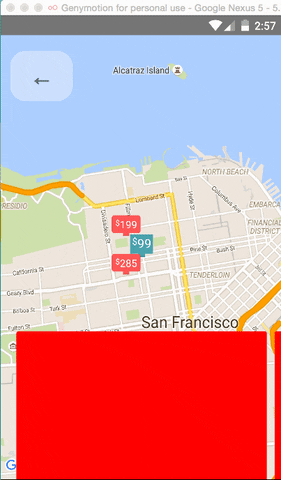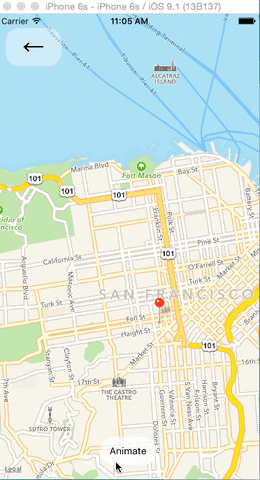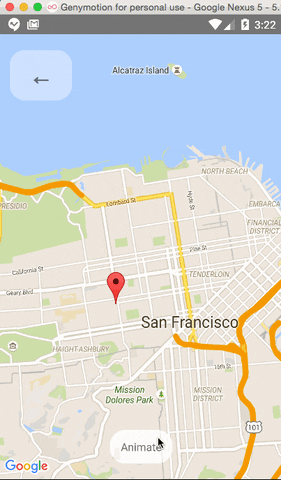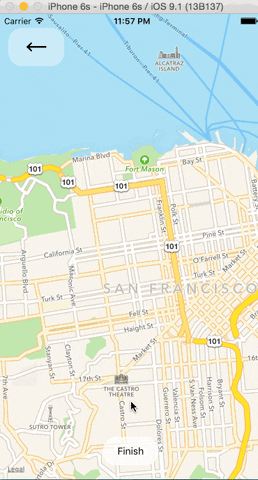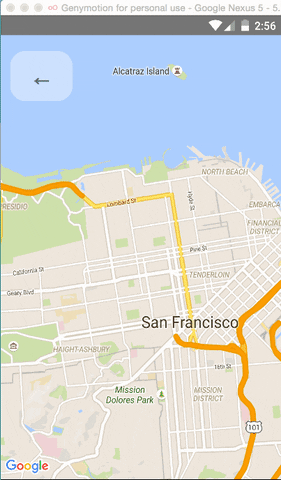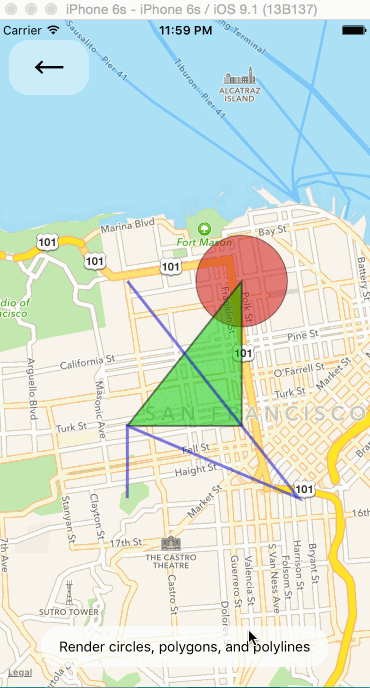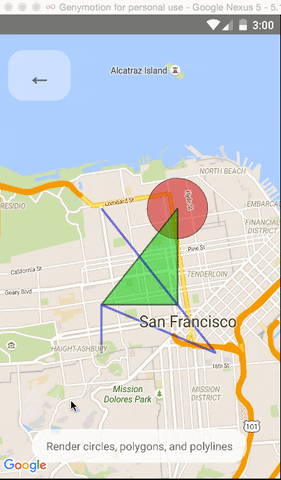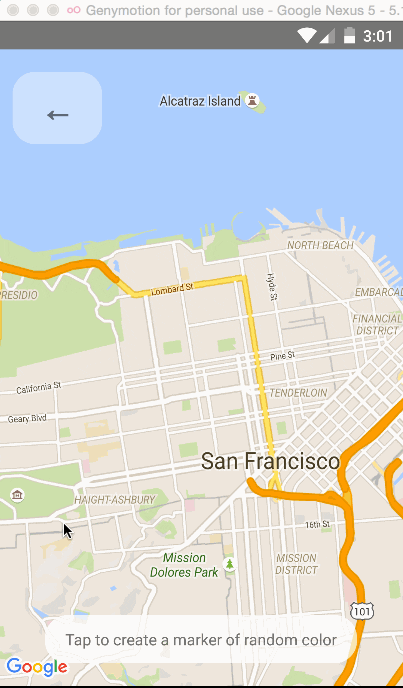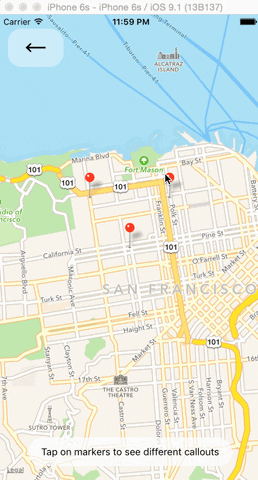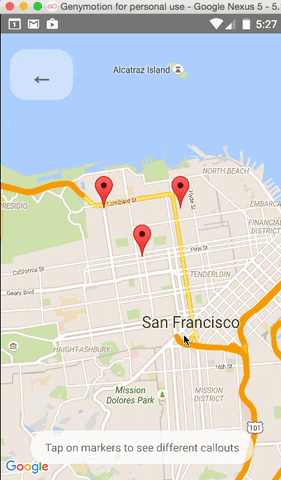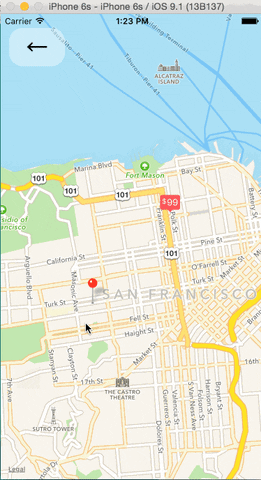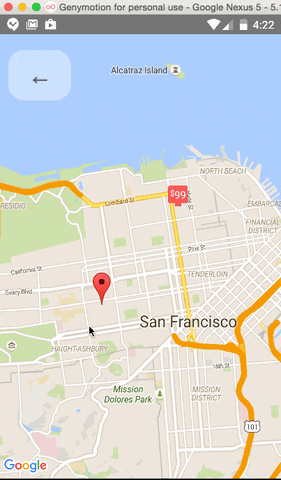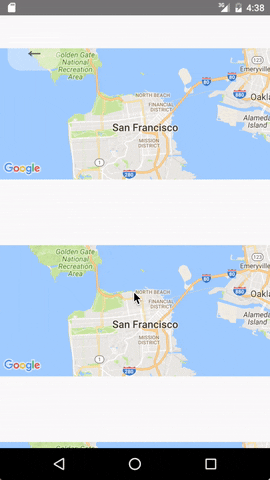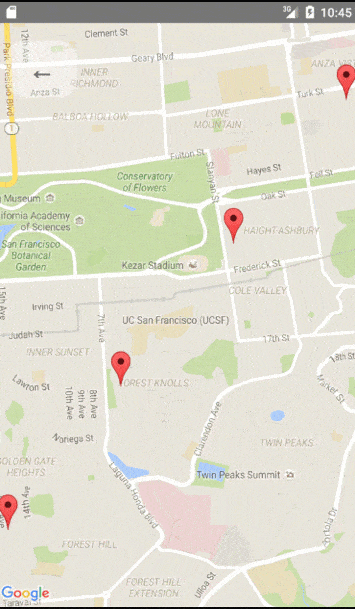React Native Map components for iOS + Android
See Installation Instructions.
See Setup Instructions for the Included Example Project.
Due to the rapid changes being made in the React Native ecosystem, we are not officially going to
support this module on anything but the latest version of React Native. With that said, we will do
our best to stay compatible with older versions as much that is practical, and the peer dependency
of this requirement is set to "react-native": "*" explicitly for this reason. If you are using
an older version of React Native with this module though, some features may be buggy.
Since react-native 0.25.0, React should be required from node_modules.
React Native versions from 0.18 should be working out of the box, for lower
versions you should add react as a dependency in your package.json.
<MapView.Marker /> Component API
<MapView.Callout /> Component API
<MapView.Polygon /> Component API
<MapView.Polyline /> Component API
<MapView.Circle /> Component API
import MapView from 'react-native-maps';or
var MapView = require('react-native-maps');This MapView component is built so that features on the map (such as Markers, Polygons, etc.) are specified as children of the MapView itself. This provides an intuitive and react-like API for declaratively controlling features on the map.
<MapView
initialRegion={{
latitude: 37.78825,
longitude: -122.4324,
latitudeDelta: 0.0922,
longitudeDelta: 0.0421,
}}
/>getInitialState() {
return {
region: {
latitude: 37.78825,
longitude: -122.4324,
latitudeDelta: 0.0922,
longitudeDelta: 0.0421,
},
};
}
onRegionChange(region) {
this.setState({ region });
}
render() {
return (
<MapView
region={this.state.region}
onRegionChange={this.onRegionChange}
/>
);
}<MapView
region={this.state.region}
onRegionChange={this.onRegionChange}
>
{this.state.markers.map(marker => (
<MapView.Marker
coordinate={marker.latlng}
title={marker.title}
description={marker.description}
/>
))}
</MapView><MapView.Marker coordinate={marker.latlng}>
<MyCustomMarkerView {...marker} />
</MapView.Marker><MapView.Marker
coordinate={marker.latlng}
image={require('../assets/pin.png')}
/><MapView.Marker coordinate={marker.latlng}>
<MyCustomMarkerView {...marker} />
<MapView.Callout>
<MyCustomCalloutView {...marker} />
</MapView.Callout>
</MapView.Marker><MapView initialRegion={...}>
<MapView.Marker draggable
coordinate={this.state.x}
onDragEnd={(e) => this.setState({ x: e.nativeEvent.coordinate })}
/>
</MapView><MapView
region={this.state.region}
onRegionChange={this.onRegionChange}
>
<MapView.UrlTile
/**
* The url template of the tile server. The patterns {x} {y} {z} will be replaced at runtime
* For example, http://c.tile.openstreetmap.org/{z}/{x}/{y}.png
*/
urlTemplate={this.state.urlTemplate}
/>
</MapView>For Android: add the following line in your AndroidManifest.xml
<uses-permission android:name="android.permission.INTERNET" />For IOS: configure App Transport Security in your app
The <MapView /> component and its child components have several events that you can subscribe to.
This example displays some of them in a log as a demonstration.
One can change the mapview's position using refs and component methods, or by passing in an updated
region prop. The component methods will allow one to animate to a given position like the native
API could.
The <MapView /> component can be made to work with the Animated API, having the entire region prop
be declared as an animated value. This allows one to animate the zoom and position of the MapView along
with other gestures, giving a nice feel.
Further, Marker views can use the animated API to enhance the effect.
Issue: Since android needs to render its marker views as a bitmap, the animations APIs may not be compatible with the Marker views. Not sure if this can be worked around yet or not.
Markers' coordinates can also be animated, as shown in this example:
So far, <Circle />, <Polygon />, and <Polyline /> are available to pass in as children to the
<MapView /> component.
Default markers will be rendered unless a custom marker is specified. One can optionally adjust the
color of the default marker by using the pinColor prop.
Callouts to markers can be completely arbitrary react views, similar to markers. As a result, they can be interacted with like any other view.
Additionally, you can fall back to the standard behavior of just having a title/description through
the <Marker />'s title and description props.
Custom callout views can be the entire tooltip bubble, or just the content inside of the system default bubble.
Markers can be customized by just using images, and specified using the image prop.
Markers are draggable, and emit continuous drag events to update other UI during drags.
Enable lite mode on Android with liteMode prop. Ideal when having multiple maps in a View or ScrollView.
The MapView can accept an MapView.AnimatedRegion value as its region prop. This allows you to utilize the Animated API to control the map's center and zoom.
import MapView from 'react-native-maps';
getInitialState() {
return {
region: new MapView.AnimatedRegion({
latitude: LATITUDE,
longitude: LONGITUDE,
latitudeDelta: LATITUDE_DELTA,
longitudeDelta: LONGITUDE_DELTA,
}),
};
}
onRegionChange(region) {
this.state.region.setValue(region);
}
render() {
return (
<MapView.Animated
region={this.state.region}
onRegionChange={this.onRegionChange}
/>
);
}Markers can also accept an AnimatedRegion value as a coordinate.
getInitialState() {
return {
coordinate: new MapView.AnimatedRegion({
latitude: LATITUDE,
longitude: LONGITUDE,
}),
};
}
componentWillReceiveProps(nextProps) {
if (this.props.coordinate !== nextProps.coordinate) {
this.state.coordinate.timing({
...nextProps.coordinate,
duration: 500
}).start();
}
}
render() {
return (
<MapView initialRegion={...}>
<MapView.Marker.Animated coordinate={this.state.coordinate} />
</MapView>
);
}currently only for ios, android implementation WIP
getInitialState() {
return {
coordinate: {
latitude: LATITUDE,
longitude: LONGITUDE,
},
};
}
takeSnapshot () {
// arguments to 'takeSnapshot' are width, height, coordinates and callback
this.refs.map.takeSnapshot(300, 300, this.state.coordinate, (err, snapshot) => {
// snapshot contains image 'uri' - full path to image and 'data' - base64 encoded image
this.setState({ mapSnapshot: snapshot })
})
}
render() {
return (
<View>
<MapView initialRegion={...} ref="map">
<MapView.Marker coordinate={this.state.coordinate} />
</MapView>
<Image source={{ uri: this.state.mapSnapshot.uri }} />
<TouchableOpacity onPress={this.takeSnapshot}>
Take Snapshot
</TouchableOpacity>
</View>
);
}Pass an array of marker identifiers to have the map re-focus.
Pass an array of coordinates to focus a map region on said coordinates.
- Make sure that you have properly installed react-native-maps.
- Check in the logs if there is more informations about the issue.
- Try setting the style of the MapView to an absolute position with top, left, right and bottom values set.
const styles = StyleSheet.create({
map: {
...StyleSheet.absoluteFillObject,
},
});<MapView
style={styles.map}
// other props
/>- When inputs don't focus or elements don't respond to tap, look at the order of the view hierarchy, sometimes the issue could be due to ordering of rendered components, prefer putting MapView as the first component.
Bad:
<View>
<TextInput/>
<MapView/>
</View>Good:
<View>
<MapView/>
<TextInput/>
</View> Copyright (c) 2015 Leland Richardson
Licensed under the The MIT License (MIT) (the "License");
you may not use this file except in compliance with the License.
You may obtain a copy of the License at
https://raw.githubusercontent.com/airbnb/react-native-maps/master/LICENSE
Unless required by applicable law or agreed to in writing, software
distributed under the License is distributed on an "AS IS" BASIS,
WITHOUT WARRANTIES OR CONDITIONS OF ANY KIND, either express or implied.
See the License for the specific language governing permissions and
limitations under the License.


